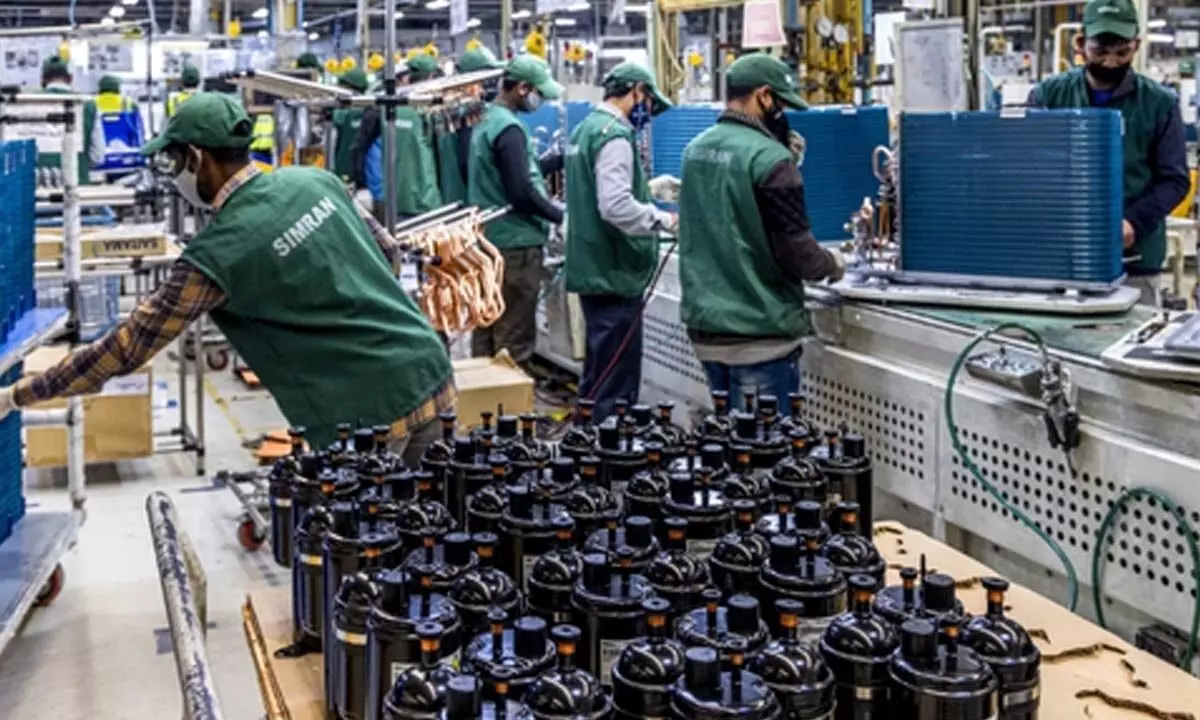Live
- Assam only state to see dip in road accidents: CM Sarma
- MP BJP to celebrate former PM Vajpayee's birth anniversary on Dec 25
- Christmas Eve 2024: Heartwarming Messages To Share With Your Loved Ones
- PM Modi holds brainstorming session with economists in run-up to Budget
- “Telangana Ready to Support AI Technologies That Drive Social Impact,” says Special Chief Secy, Jayesh Ranjan at Woxsen University’s Future Tech Summit 2024
- Hero Motosports Team Rally Announces Squad For Dakar Rally 2025
- Two Men Found Dead In Parked Caravan In Kerala
- Mandhana moves closer to top spot in ODI, T20I rankings
- IND vs AUS Boxing Day Test 2024: Sam Konstas Debuts, Travis Head’s Fitness in Question
- Congress Challenges Election Rule Amendments In Supreme Court
Just In
Mild recovery not enough; manufacturing needs to grow faster to create jobs

India’s manufacturing sector staged a mild recovery in the last quarter of 2022-23, after half a year of contraction, and continued to expand at a moderate pace with a 4.7% growth in the first quarter of the current financial year.
New Delhi: India’s manufacturing sector staged a mild recovery in the last quarter of 2022-23, after half a year of contraction, and continued to expand at a moderate pace with a 4.7% growth in the first quarter of the current financial year.
Official figures released on Thursday show a 9.3% growth in the manufacturing sector during August but this is compared to a low base of the previous year when output contracted.
Since the manufacturing sector holds the key to providing quality jobs to the country’s young graduates passing out of engineering institutes and universities, it needs to grow at a much faster and steadier pace.
The Government’s National Manufacturing Policy has set an ambitious target to increase the share of manufacturing in the country’s GDP to 25 percent by 2025 from around 17 percent at present.
The productivity linked incentive (PLI) scheme for a big push to manufacturing, launched in 2022 with an allocation of Rs 1.97 lakh crore, has produced some good results but not gone far enough.
The PLI scheme has succeeded in industries such as mobile phone manufacturing with companies such as US tech giant Apple and Taiwan-headquartered multinational company Foxconn setting up manufacturing facilities in the country and giving a major fillip to exports as well. Pharmaceutical companies, medical device manufacturers, and food processing industries are other areas that have done well.
However, the PLI scheme has not produced the desired results in other segments such as the manufacture of solar PV modules, and electric vehicles.
Another positive outcome has been that India has become an increasingly attractive location for multinationals across a wide range of industries, with foreign direct investment (FDI) inflows touching a record high of USD 85 billion in the 2021-22 fiscal year, according to the RBI. With global players looking to set up supply chains outside China, India’s large domestic market provides an ideal alternative.
Major investments such as the Airbus-Tata joint venture to manufacture military planes in Vadodra has also taken off this year. Similarly, work is on to set up a factory to produce semiconductors by US chip giant Micron Technologies near Ahmedabad.
However, slowing global growth which is dragging down exports, geopolitical risks and volatile global financial conditions weigh heavily on the outlook ahead for the manufacturing sector.
India has retained its position as the fastest growing large economy ahead of China in the IMF’s latest forecast on economic growth rates. However, according to a report by Barclays, India needs to grow at 8% for some years in order to overtake China in terms of contribution to the global economy. This is because China’s GDP is $17.7 trillion which is about five times that of India.
India’s growth has also been largely driven by the services sector which contributes as much as 55% to the country’s GDP with the manufacturing sector’s share at around 17%.
The government’s jobs data showed that since 2018-19, the last pre-pandemic year, and 2022-23, a part of the labour force has gone back to agriculture. In 2022-23, agriculture’s share of the workforce was 45.8%, over three percentage points more than 2018-19. The change in composition was partly on account of a modest decline in the workforce engaged by the manufacturing sector. In 2022-23, only 11.4% of the country’s workforce was in manufacturing.
The Barclays report points out that, India needs to invest more investments in traditional sectors such as mining and power utilities to surpass China as the biggest contributor to world GDP.
Investments in those sectors have taken a back seat in recent years compared to newer industries, such as telecommunications and the digital sector, Rahul Bajoria, a senior economist at Barclays, wrote in the report.
More investment, especially in traditional sectors, should also have a positive impact on employment and household income, and this could help policy makers to formulate better policies for economic growth, he added.

© 2024 Hyderabad Media House Limited/The Hans India. All rights reserved. Powered by hocalwire.com






